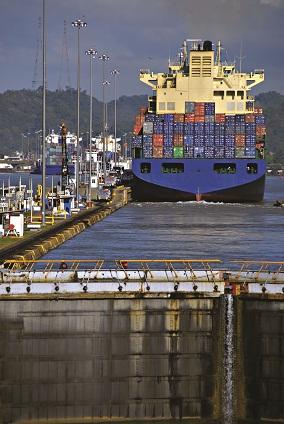
 Since the birth of our nation, United States seaports and navigation channels have served as a vital economic lifeline by bringing goods and services to people around the world and by delivering national prosperity. Seaports facilitate trade and commerce, create jobs, help secure our borders, support our military and serve as stewards of valuable coastal environmental resources.
Since the birth of our nation, United States seaports and navigation channels have served as a vital economic lifeline by bringing goods and services to people around the world and by delivering national prosperity. Seaports facilitate trade and commerce, create jobs, help secure our borders, support our military and serve as stewards of valuable coastal environmental resources.
They are responsible for moving more than 99 percent of our country’s overseas cargo while international trade accounts for more than a quarter of America’s Gross Domestic Product.
America’s seaports support 13.3 million U.S. jobs, which account for $649 billion in annual personal income. According to the U.S. Chamber of Commerce, for every $1 billion in manufactured goods exported through America’s seaports, 15,000 U.S. jobs are created.
Although our nation’s ports are dynamic, vibrant centers of trade and commerce, they rely on federal and private partnerships. U.S. seaports and their private-sector business partners anticipate investing more than $9 billion annually for each of the next five years to maintain and improve their freight- and passenger-handling infrastructure. Unfortunately, the federal government isn’t adequately matching this with concomitant investments in connecting land- and water-side infrastructure to effectively handle increasing cargo volumes.
This lack of federal foresight causes inefficiencies in moving cargo to and from ports, resulting in time delays, reduced international competitiveness for U.S. exports, and increased prices and product shortages for consumers.
Despite there being a federal Harbor Maintenance Tax on seaport cargo that raises 100 percent of the revenue needed for maintaining America’s harbors and channels at their required dimensions, only about half of that money is being appropriated for its intended purpose, resulting in serious dredging needs being neglected. At the same time, federal funding for constructing deeper navigation channels has all but disappeared, although project sponsors—usually ports—pay between 35 percent and 60 percent of the cost, depending on project depth.
Landside connections with ports also continue to be a low federal priority, with little of the highway funds going to freight transportation projects. To provide some comparison to what the U.S. government is spending on intermodal connections with America’s seaports, the Transportation Equity Act for the 21st Century directed the U.S. Department of Transportation secretary to conduct a review of the National Highway System (NHS) freight connectors that serve seaports, airports and major intermodal terminals, and report to Congress by June 9, 2000. The Federal Highway Administration conducted this study with the following objectives: (1) evaluate the condition of NHS connectors to major intermodal freight terminals; (2) review improvements and investments made or programmed for these connectors; and (3) identify impediments and options to making improvements to the intermodal freight connectors.
The 2000 study results, which were followed by an update in 2002, concluded:
• Connectors to ports have twice the percent of mileage with pavement deficiencies when compared to non-Interstate NHS routes, such as airports.
• Problems with shoulders, inadequate turning radii and inadequate travel-way width were most often cited as geometric and physical deficiencies with connectors.
• When the top-five terminals with the largest reported investment were eliminated from the database for each of the terminal types, such as California’s Alameda Corridor and San Francisco airport, average investment levels on a per-mile basis were significantly lower than the non-Interstate mainline NHS.
Although the report is now a decade old, these problems have unfortunately not improved and intermodal connectors are still significantly underfunded.
The past four rounds of federal Transportation Investments Generating Economic Recovery (TIGER) grants—of which about 13 percent overall went to port-related projects—and Congress’ passage on June 29 of the MAP-21 surface transportation reauthorization bill—which includes language in support of maintaining federal navigation channels and creating a national freight plan—have offered some bright spots. These, however, are overshadowed by an otherwise troubling picture of the federal government paying scant attention to the needs of freight, freight mobility and the connections freight needs to access our seaports.
As we recover from the economic downturn, we must make investments today to address the trade realities of the future. Ship sizes continue to get larger, requiring ongoing modernization of ports and federal navigation channels, even for ports that don’t require 50 feet of depth. Panama has recognized the need to modernize and has underway a major expansion of the Panama Canal slated for completion in 2015. Canada and Mexico are also making significant investments which could result in losses of U.S. maritime jobs as cargo enters the U.S. through these countries. The U.S. seeks to double exports; however, countries like Brazil and Chile that compete against the U.S. in terms of agricultural exports are making investments that could make their exports more competitive.
In addition to these near-term challenges, we know that the U.S. population is forecast to grow by 100 million – a 30-percent increase – before the middle of the century, and many of the goods used by this population will need to flow through seaports.
While ports are planning for the future, the federal government hasn’t kept pace with the industry or our international competitors. The federal government has a unique Constitutional responsibility to maintain and improve the infrastructure that enables the flow of commerce, and much of that infrastructure in and around seaports has been neglected for too long.
Many of our land and water connections are insufficient and outdated, affecting the ports’ ability to move cargo efficiently. This hurts U.S. business, U.S. workers and our national economy.
Federal investments in seaports are an essential and effective utilization of limited resources, paying dividends through increased trade and commerce, long-term job creation, secure borders, military support, environmental stewardship, and more than $200 billion in federal, state and local tax revenue.
All of this raises the question: What must the nation do to ready its ports for the future?
First, the federal government must make funding for dredging maintenance and improvements a higher priority. Congress must pass legislation that results in more funding for port, freight and landside infrastructure, including extending the TIGER grants program. Finally, Congress must reauthorize and provide adequate funding for the Port Security Grant Program and environmental programs, such as the Diesel Emissions Reduction Act that provides grants that ports use to lower emissions from trucks, trains, ships and other “transient” sources.
On another front, new trade agreements with Korea, Panama and Colombia were recently approved, and other trade agreements are under negotiations. Trade agreements such as these should be encouraged because they result in more U.S.-made products being sold overseas, more goods moving across port docks to fuel our economy, and more jobs being created to handle all those goods.
As our nation recovers from its economic troubles, cargo volumes will continue to grow. As our nation invests in transportation infrastructure, we must ensure that ports and their needs to efficiently move freight are high on the list.
Today, we face enormous challenges and ports are making the necessary investments to build and maintain a world-class maritime transportation system, which supports U.S. jobs, our global competitiveness and our economy. We need our federal partner to make that commitment, too.
Because seaports deliver prosperity, we urge you to serve as advocates for port infrastructure so that America’s ports can meet the challenges for today and tomorrow.


